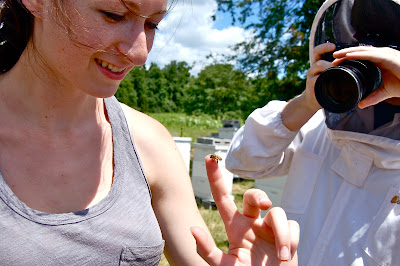When I first became gluten free, I essentially focused on eating “whole grain” foods such as rice, potatoes, corn, and quinoa. I bought a block of brown rice bread to make toast, both the toaster and French kind, and swore by rice crackers to anyone who would listen. As far as I was concerned, that was all I needed.
Transitioning to the gluten free lifestyle in 2008 was the perfect time to be gluten free. Cookbooks and baking mixes and labeling were showing up everywhere and in abundance. I started to do research, buying mixes and cookbooks, and became interested in food like I never was in my BGF days. While I was rather obsessed in a less than healthy way about what I considered to be healthy food and eating, I never thought how much I would change simply because I took wheat/gluten out of my diet.
When I was finally diagnosed with hypothyroidism in April of last year, I felt it was the perfect opportunity to unveil my idea for
Meals with Morri. The blog itself had been sitting dormant for almost a year, and I still had no idea what my focus what going to be (aside from the gluten free lifestyle, of course). After the diagnosis, however, I became enthralled with how to live a happier and healthier life, and for some reason it was extremely food-oriented. It took another year before I started really looking into understanding how diet and other lifestyle choices affected a person with hypothyroidism, and how I could help the world by providing recipes, storytelling, and current events (the third being a relatively new concept on this blog).
Meals with Morri has been viewed by people from all over the world, and I am so humbled to see how far it has come in a year. And although I consider myself still a novice with big dreams, I will never forget where it all started.
It all started with bagels.
Bagels were the epitome of my childhood. There were nights where Mama Dazz and I couldn’t sleep and we’d have late-night bagel parties in the kitchen. When I attended Catholic school and sang in the choir, we went to Einstein’s Bagels after the one Sunday a month I was required to sing for a sermon. (I always got lox on an "everything" bagel. Best. Combination. EVER.) Whenever we went on vacation and had to drive somewhere, like Virginia Beach, New York, or North Carolina, I ordered a McDonald’s breakfast sandwich as, you guessed it, a bagel.
Bagels were my favorite baked good, and I loved it with cream cheese, jam, peanut butter, honey, butter, etc. When I became gluten free, I was not impressed with the options I had, so I did the most logical thing I could think of: I made them myself.
 |
| My 2010 Bagel success. |
My “I have no idea on the fundamentals of gluten free baking so I’m going to wing it” experience with bagels were simple enough: gf baking mix +
gf bagel recipe = gf bagels. But then I started playing around with flours and gums, mainly rice flour, glutinous rice flour, tapioca starch, and xanthan gum, and I liked the results much better. For some reason, though, I stopped trying to perfect bagels even before
Meals with Morri was a sparkle in my eye.
Soon after, the Gluten Free Ratio Rally rekindled my desire for a delicious bagel.
What I love the most about this movement is the joint effort of showing the world that, if you have a ratio for a recipe, you can use just about anything to make it. Whatever the types of flours, liquids, sweeteners, or binders you use, having a ratio makes it possible. Measuring ingredients by weight is fundamental for this process, even for those not living the gluten free lifestyle. Cake flour does not have the same properties as whole-wheat flour, so we should not assume garbanzo bean flour is the same as buckwheat flour. True, many flours can be and are interchangeable, but having a scale makes it significantly easier to experiment with different ingredients and flour combinations. What the GFRR has done is bring a lot of passionate people from all over cyber space, many with additional dietary restrictions to consider, and turn a ratio into a recipe that can be enjoyed by many who have to work around the same allergies, intolerances, and health issues. It is a movement to show how empowering it is to embrace your so-called dietary/health “restrictions”.
If you have a ratio, i.e. a foundation for a recipe, you can make/do anything.
When the spaces for the 2012 months needed to be filled, I enthusiastically exclaimed that April would be all about bagels and that I’d love to host the process. Despite my getting sick for the majority of the month, I made many batches of bagels. After all, I was hosting. With
Udi’s making a bagel that looked and acted like one (never ate one personally, but I’ve heard positive reviews), I felt there was this expectation to making
The Perfect Bagel,
especially since I was hosting. And despite my learning that I should keep it simple before dressing up the recipe, I went ahead and dressed it up anyway.
I had in mind to create a sweet potato bagel, but I started getting frustrated with the trials. That, and we were running out of sweet potatoes.
The first thing you must realize when making bagels is: do not use the entire yeast packet.
Bruce Ezzell’s bagels called for 3 g of yeast to his 1.9:1 flour:water ratio (or 2.25:1 sponge:flour ratio if you prefer), and for some reason I was surprised how yeasty and “spongey” the dough was when I put
seven times the amount of yeast in it. It tasted sour and I had to add over 100 g of additional flour to compensate.
The second trial, in addition to correcting the yeast amount, focused on changing how I used the sweet potato. For the first trial, I used it as part of the flour ratio, which probably made the dough wetter than it should have been. So I used it as the “liquid”, making it dry and having to balance that issue with additional liquid, going from too dry to too wet in seconds. Instead of putting in flour, however, I put in whole CGF rolled oats. I still wasn’t content with the bagels, but the oats did something to the flavor and the texture that reminded me of a hearty bagel.
To be honest, the sweet potato bagel was not my first bagel idea. My
original idea was to make a blueberry bagel, but not in the traditional sense. With my CGF oats, both whole and powdered, my mad scientist tendencies were flaring up and I was inspired to try out my blueberry idea. So what did I do? I bought freeze-dried blueberries, powdered the dickens out of them, and incorporated that blueberry flavor (and purplish color) throughout the entire bagel.
As hostess, I stuck with Ezzell’s ratio as best as I could, though I think I would have liked the recipe better made with other binders like egg. But I followed the directions and used the ratio that was given to me, even making it vegan-friendly. I halved the recipe due to the overabundance of bagels on the kitchen counter, and it will make a week’s worth of bagels you can eat for breakfast each morning with a smear of nut butter or cream cheese.
Will I try again? Definitely. Will I compare the difference between the “traditional” bagel versus the ones made with eggs and oil? Oh, yes.
For now, I give you my recipe for this month’s GFRR, and it was such an honor to host it.











































